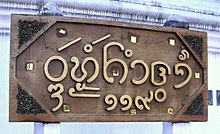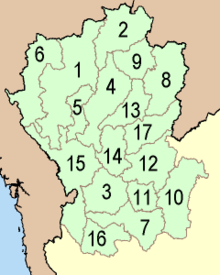Northern Thailand
Northern Thailand ( Thai : ภาค เหนือ , pronunciation: [ pʰâːk nɯ̌a ]) is one of the regions in Thailand that were defined for geographical and statistical purposes, but which have no political significance. Northern Thailand is also its own cultural area.
The northern region in the narrower sense, according to the six-region model of the National Geographic Committee, comprises the nine provinces ( Changwat ) of the Thai highlands. According to the four-region system, as it is used in certain statistical and administrative contexts, an extended northern Thailand includes a total of 17 provinces. Chiang Mai is the cultural and economic center of the region .
geography
The north of Thailand is characterized by several mountain systems: the Daen Lao Mountains in the north, the Thanon Thong Chai Mountains in the west and the Phi Pan Nam Mountains and the Luang Prabang Mountains in the east. The highest mountain in Thailand Doi Inthanon is also located in the region. Due to the higher altitude, the temperatures are usually significantly lower than in central Thailand , and in the mountains there can even be night frosts in winter. The main rivers are Mae Nam Yom , Mae Nam Ping , Mae Nam Wang and Mae Nam Nan .
history
The history of northern Thailand proper is essentially that of the Kingdom of Lan Na . It was founded in the 13th century and flourished in the 15th century. In the later centuries the region was more often a theater of war between the Siamese and Burmese empires , some of the cities were completely depopulated. Only after the fall of Ayutthaya and the rise of Siam under King Taksin was Lan Na permanently obliged to pay tribute as the king's vassal in Bangkok from 1774 .
Under the impression of the colonization of large parts of Southeast Asia, what is now northern Thailand was increasingly tied to Bangkok in the second half of the 19th century. With the reforms of Prince Damrong Rajanubhab in 1899, it was first integrated into the Thai central state as Monthon Phayap and later as several provinces. Even in the 21st century, there are still measurable political differences between this region and central and southern Thailand: The former Prime Minister Thaksin Shinawatra , who was born in Chiang Mai, and his parties traditionally have the highest support rates here. In the referendum, the 2007 constitution, drawn up under the aegis of the military, was rejected by a majority in the provinces that were formerly part of Lan Na.
The provinces of the northern Chao Phraya basin, which are closer to central Thailand - the “lower north” - have a different story. The center of the Sukhothai Kingdom was located here in the 13th to 15th centuries . From 1438 they were integrated into the central Thai Kingdom of Ayutthaya , but retained a certain autonomy within the framework of the feudalist mandala model . Attempts by the northern Lan Na to expand its influence in this area failed. As a result, the culture and language here is more influenced by that of central Thailand.
Population, language and culture

The majority population (80%) of northern Thailand, belonging to the group of the Tai peoples , was regarded in the past as a separate ethnic group of the (Tai) Yuan or even as western Lao , but not as actual Siamese (old name for Thai ). They referred to themselves as Khon Müang ("people of our Müang ") and had their own language, which is called the Lanna language after the northern Thai kingdom - the Tai Yuan themselves refer to them as Kam Müang ("language of our Müang "). This was written with the Lanna alphabet , also called Dhamma script. From 1939 onwards, the whole of Thailand was to be unified within the framework of the nationalist policy of Prime Minister Phibunsongkhram and to be unified in ethnic and cultural terms ( Thaiization ). Ethnic and regional differences could no longer be spoken of. All Thais (with the exception of the hill tribes recognized as minorities ) had to be called Thai (no longer Lao or Yuan). The use of the central Thai dialect was also promoted in northern Thailand. The Lanna script was no longer allowed to be used.
Today, 6 million people in northern Thailand speak Kam Müang as their mother tongue. However, almost all of them can also speak standard Thai, which is taught in schools, written in newspapers and spoken on the radio. Since the 1990s there have been ethnic and regionalist tendencies again in the Chiang Mai area. This was particularly evident during the 700th anniversary of Chiang Mai in 1996, at which some northern Thais proud of the much older history of their “capital” compared to the relatively young Bangkok. On special occasions, some northern Thai women, especially the middle and upper classes, consciously dress in the traditional style of the peoples of the north. Occasionally, signs with letters written in Lanna are put up to emphasize a certain regional character. Regional traditions are also used commercially and for tourism.
As recognized ethnic minorities, different ethnic groups live in northern Thailand, which are summarized as " mountain peoples ". The most important of these are Karen , Lisu , Akha , Lahu , Mien ( Yao ) and Hmong . Most of them immigrated from southern China and Burma in the 19th century. Around a million people belong to these peoples with their own cultural traditions, languages and beliefs.
Administrative structure
The regions of Thailand are not local authorities, but are only defined for geographical, statistical or certain administrative purposes. According to the six-region model, the northern region is assigned nine provinces, and according to the four-region system, 17 provinces.
The table on the left contains the provinces of northern Thailand in the narrower sense. On the right are the provinces, which are part of the further definition of northern Thailand, geographically and culturally, however, are part of central Thailand, and the province of Tak is part of western Thailand.
|
|
literature
- The North. In: Volker Grabowsky (Ed.): Regions and National Integration in Thailand, 1892–1992. Harrassowitz Verlag, Wiesbaden 1995, ISBN 3-447-03608-7 , pp. 13-104. With contributions by Hans Penth, Harald Uhlig, Harald Hundius , MR Rujaya Abhakorn and David Wyatt, Thanet Charoenmuang and Ronald Mix.
Web links
Individual evidence
- ^ Volker Grabowsky: Brief history of Thailand. CH Beck, Munich 2010, ISBN 978-3-406-60129-3 , p. 192.
- ^ Volker Grabowsky: Brief history of Thailand. CH Beck, Munich 2010, pp. 189-190.
- ^ Charles F. Keyes: Cultural Diversity and National Identity in Thailand In: Government policies and ethnic relations in Asia and the Pacific. MIT Press, 1997, pp. 200ff.
- ^ Volker Grabowsky : Brief history of Thailand. CH Beck, Munich 2010, ISBN 978-3-406-60129-3 , p. 158.
- ↑ Chris Baker , Pasuk Phongpaichit: A History of Thailand. 2nd Edition. Cambridge University Press, 2009, ISBN 978-0-521-76768-2 , p. 133.
- ↑ Keyes: Cultural Diversity and National Identity in Thailand 1997, pp. 215f.
- ↑ Pinkaew Laungaramsri: Ethnicity and the politics of ethnic classification in Thailand. In: Ethnicity in Asia. Routledge Shorton, London / New York 2003, p. 163.


